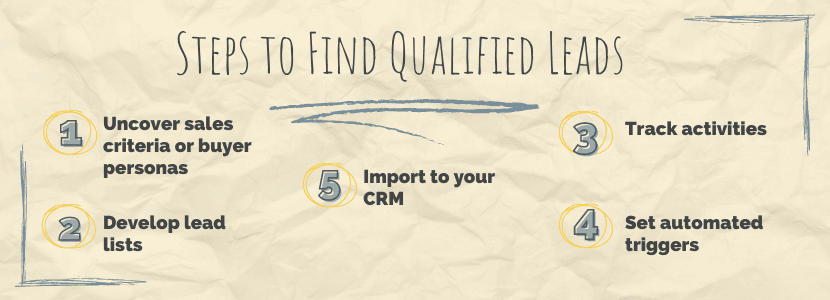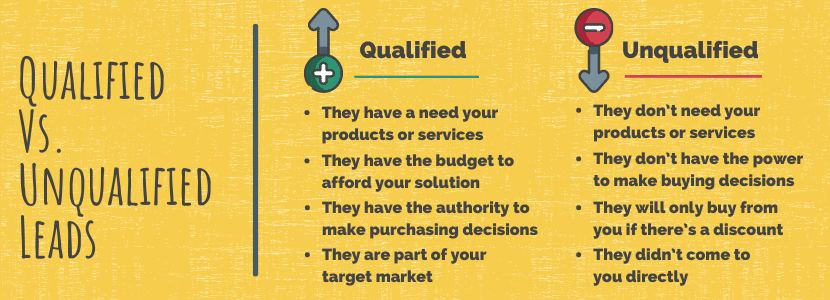Are you spending time and money generating leads for B2B that may not be qualified? In this blog post, we’ll explore the differences between qualified and unqualified B2B leads and how you can avoid wasting your resources on the latter. Once you understand what makes a lead qualified and the core principles of account-based marketing (ABM), you can target and generate leads that are more likely to convert into customers. So, let’s get started!
What is a qualified lead?
If you’re in the business of selling to other businesses in Nashville – or anywhere for that matter – then you know that lead generation for B2B sales is essential to your success. But what exactly makes a qualified B2B lead? Here are a few key characteristics to look for:
- They have a need or pain point that your product or service can solve.
- They have the budget to afford your solution.
- They have the authority to make purchasing decisions within their organization.
- They are located in Nashville – or whatever other geographical area you serve.
- They are part of the target market that you’re aiming to reach.
Keep these criteria in mind when generating B2B sales leads, and you’ll be well on your way to closing more deals.
What is an unqualified lead?
As B2B lead generation agencies will tell you, most B2B businesses are constantly looking for new leads, but the most frustrating part is that many of their strategies just don’t work. And without a means to determine what kind of lead fits the criteria of an ideal customer, you’ll likely end up wasting a lot of time and money talking to folks who don’t convert into a sale.
Here are a few examples of what makes an unqualified lead:
- They don’t need – or have an interest in – your products or services.
- They don’t have the power to make buying decisions.
- They will only consider buying from you if there’s a “promotional discount”.
- They didn’t come to you directly; they came to you via a “lead list” you purchased from a broker.
There are countless ways to acquire leads – from giving discounts to purchasing lead lists. However, some lead-generation efforts can fill the pipeline with more unqualified leads than qualified ones.
Why are qualified leads important?
Every business is built on leads, and qualified leads are much easier to sell to than unqualified ones. Whether you’re a small business or a large enterprise, generating qualified leads and making sales is essential to your success. You can have the best product in the world, but if you don’t have anyone to sell it to, your business will struggle.
Without leads, you have no customers. Without customers, you have no business.
That’s why generating B2B sales leads is crucial for business growth and success. Without a steady stream of qualified B2B leads, keeping your sales pipeline full and your business moving forward will be challenging. Fortunately, there are a number of ways to generate leads. From online ads to trade shows, there are plenty of opportunities to get your product in front of potential customers who need what you’re selling.
The key is to be strategic about your lead generation efforts and target the right people. That way, you’ll build a foundation of qualified B2B sales leads with a higher potential for lifetime-customer value.
How do I find qualified leads?
B2B lead gen can be a tough nut to crack when you’re just getting started in your sales planning. Where do you even start looking when you need qualified leads? And once you’ve found them, how can you be sure they’re actually qualified? Here are a few tips to get you started on your B2B lead gen journey and on your way to getting more leads.

Uncover sales criteria or buyer personas
Generating leads is essential to the success of any business. Did you know that the average small business fails to convert 79% of generating leads for B2B to a sale, though? Far too many B2B marketers make the mistake of failing to define their target audience properly. As a result, they waste valuable time and resources to get B2B leads that will never convert.
Before you can start generating leads for B2B, take the time to determine your sales criteria and buyer personas. This will help you define some essential information you need to know about the buying behaviors of your target customers. For example: what are the pain points of your ideal customer? What features and benefits do they value, and what motivates them to make a purchase? Once you have a clear idea of who you’re trying to reach, you can start developing strategies for finding qualified leads. Without a well-defined target audience, you’ll always struggle to generate your desired results.
Develop lead lists
A lead list is simply a list of potential customers that you can contact to close deals and drive revenue. But developing a high-quality lead list can be difficult. First, you need to identify your target market and figure out who your ideal customer is.
Once you know who you’re trying to reach, you need to find ways to generate leads. This can be done through online research, social media, trade shows, or even word of mouth. Once you have a list of potential leads, it’s time to start reaching out and making sales!
Unlike other B2B lead generation agencies, Take the Stairs develops qualified B2B lead lists for our clients through a proprietary methodology and tool kit we’ve developed using LinkedIn Sales Navigator. This sales management tool provides access to over 690 million users. With filters unmatched by any other lead gen database on the market, you can hyper-target your ideal customer base.
Import to your CRM
If your business actively generates leads, you know that it can be challenging to keep up with your potential customers, especially if you don’t have a CRM (customer relationship management) system. But what is a CRM, exactly? A CRM is a software application that helps businesses manage and organize customer relationships. It can be used to track B2B sales leads, active customers, sales opportunities, and more.
Importing your lead list into a CRM is the first essential step you’ll want to take to keep track of your prospects and promptly follow up with them. There are a few different ways to import your lead list into a CRM: manually, via CSV file, or using an integration tool like Zapier.
Whichever method you choose, importing your lead list into a CRM will help you stay organized as you close more deals and grow your business.
Track activities
There’s nothing more frustrating than reaching out to a lead only to have them go dark on you. It happens to the best of us, but the good news is that there are ways to track your leads to see what they’re up to after you reach out to them. One way to do this is to use a B2B lead gen platform that allows you to see when your leads open your emails, click on your links, or download your content. That way, you’ll know when they’re engaging with your brand, and you can follow up accordingly.
Another way to track your leads is through social media. Most platforms allow you to see who’s been visiting your profile, so if you see that a lead has been checking you out, you can reach out and connect with them. Finally, you can always ask your leads how they found out about you. This can give you valuable insights into what marketing channels are working (or not working) for you and help you adjust your strategy accordingly.
Tracking your leads doesn’t have to be complicated or time-consuming. By using the methods above, you can get a better idea of how your leads are engaging with your brand and take steps to capitalize on those interactions.
Set automated triggers
You need to set up automated triggers to make sure your B2B leads are moving through your funnel. Otherwise, you’ll just be sitting around waiting for someone to take action, and that’s a recipe for disaster. By setting up triggers, you can make sure that each lead gets the attention they need based on their actions.
For example, if a lead opts into your newsletter, you can set a trigger to send them a series of emails with valuable content. If they download a white paper from your website, you can set a trigger to reach out and see if they’re interested in learning more about your product. The possibilities are endless, but the important thing is that you take action and move your leads through your funnel.
Does your business need help generating leads for B2B?
 So, what’s the takeaway? If you want to get more leads and close more deals, start thinking about your sales process regarding qualified and unqualified leads. Then, use lead gen tactics that focus on finding quality leads. And last but not least, engage those leads properly to convert them into paying customers.
So, what’s the takeaway? If you want to get more leads and close more deals, start thinking about your sales process regarding qualified and unqualified leads. Then, use lead gen tactics that focus on finding quality leads. And last but not least, engage those leads properly to convert them into paying customers.
At Take the Stairs, we have a lot of experience generating leads for B2B and account-based marketing (ABM). Contact our Nashville lead gen office today to learn how we can help you take your business to the next level.








